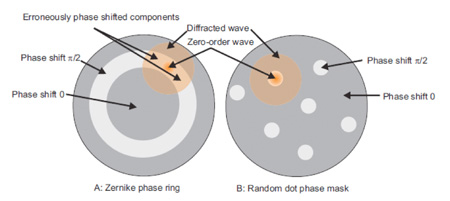Aberration correction and artifact reduction:
SLMs are valuable tools for iterative corrections of phase aberrations, e.g. based the Gerchberg-Saxton algorithm. One may for instance use the dark center of a single optical vortex as a very critical sensor for residual phase aberrations:
 |
Publication(s):
A. Jesacher, A. Schwaighofer, S. Fürhapter, C. Maurer, S. Bernet, and M. Ritsch-Marte: Wavefront correction of spatial light modulators using an optical vortex image, Optics Express 15, 5801-5808 (2007).
Zernike phase contrast microscopy uses an annular illumination ring aperture and a matching phase ring in the back focal plane of the objective. This geometry is chosen in order to increase the effective numerical aperture and thus the resolution. although it entails the well-known “halo”- and “shade-off” artifacts. These artifacts originate from higher diffraction orders along the ring (of width corresponding to the zeroth diffraction order) that are inevitably phase-shifted, although they should not be.
 |
The flexible programmability of SLMs provides a means to improve the performance: in Random Dot Phase Contrast firstly one replaces the illumination ring by a set of small circular apertures which are randomly distributed over the whole aperture of the condenser (without changing the total effective illumination area) and secondly one replaces the Zernike phase ring by a matched set of phase shifters in the back focal plane of the objective. This significantly reduces the halo and shade-off artifacts whilst providing the full spatial resolution of the microscope.
 |
 |
Publication(s):
C. Maurer, A. Jesacher, S. Bernet, and M. Ritsch-Marte: Phase contrast microscopy with full numerical aperture illumination, Opt. Express 16, 19821-19829 (2008).



